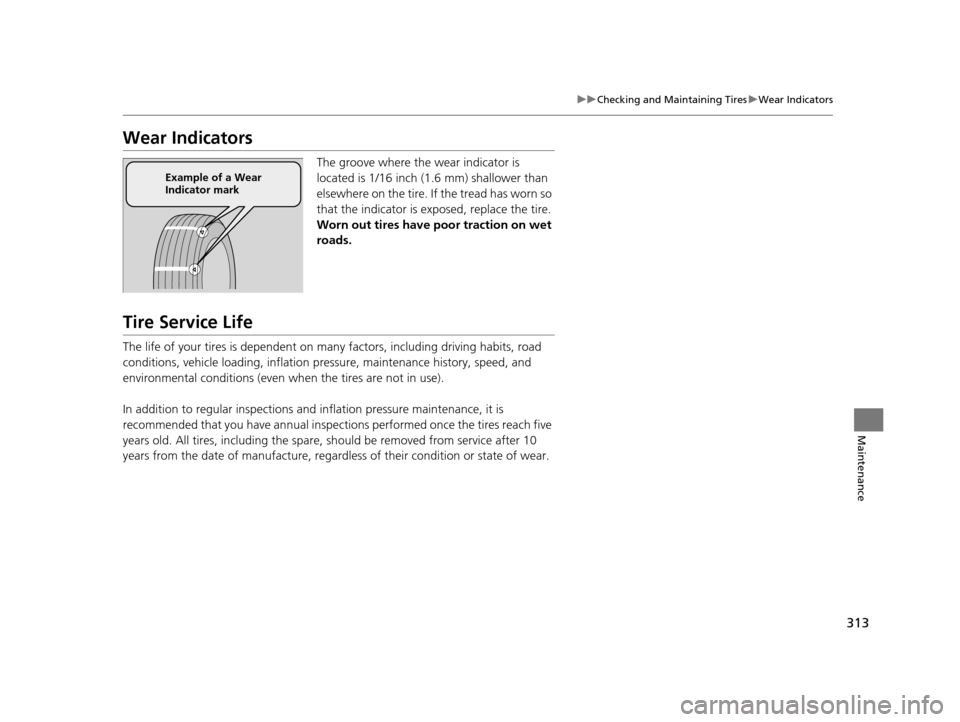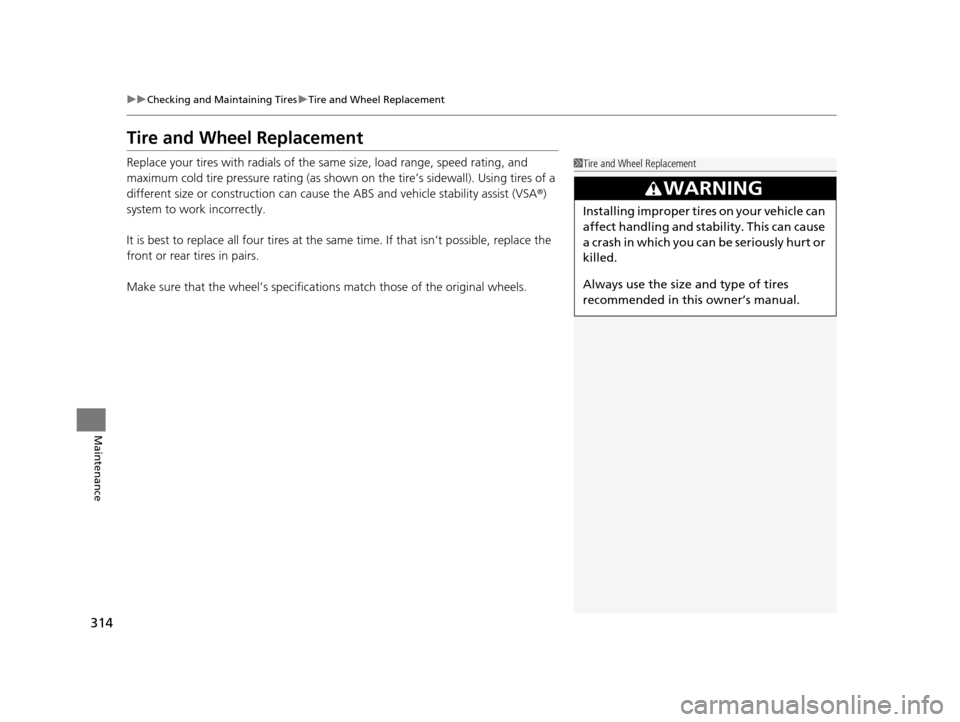2015 HONDA CIVIC HYBRID Pressure
[x] Cancel search: PressurePage 314 of 377

313
uuChecking and Maintaining Tires uWear Indicators
Maintenance
Wear Indicators
The groove where the wear indicator is
located is 1/16 inch (1.6 mm) shallower than
elsewhere on the tire. If the tread has worn so
that the indicator is ex posed, replace the tire.
Worn out tires have po or traction on wet
roads.
Tire Service Life
The life of your tires is dependent on many factors, including driving habits, road
conditions, vehicle loading, inflation pressure, maintenance history, speed, and
environmental conditions (even wh en the tires are not in use).
In addition to regular inspections and inflation pressure maintenance, it is
recommended that you have annual inspections performed once the tires reach five
years old. All tires, including the spare, should be removed from service after 10
years from the date of manufacture, regardle ss of their condition or state of wear.
Example of a Wear
Indicator mark
15 CIVIC IMA-31TR26300.book 313 ページ 2014年9月9日 火曜日 午後12時20分
Page 315 of 377

314
uuChecking and Maintaining Tires uTire and Wheel Replacement
Maintenance
Tire and Wheel Replacement
Replace your tires with radials of the sa me size, load range, speed rating, and
maximum cold tire pressure ra ting (as shown on the tire’s sidewall). Using tires of a
different size or construction can cause the ABS and vehicle stability assist (VSA®)
system to work incorrectly.
It is best to replace all four tires at the same time. If that isn’t possible, replace the
front or rear tires in pairs.
Make sure that the wheel’s specifications match thos e of the original wheels.1Tire and Wheel Replacement
3WARNING
Installing improper tires on your vehicle can
affect handling and stability. This can cause
a crash in which you can be seriously hurt or
killed.
Always use the size and type of tires
recommended in this owner’s manual.
15 CIVIC IMA-31TR26300.book 314 ページ 2014年9月9日 火曜日 午後12時20分
Page 323 of 377

322
uuCleaning uExterior Care
Maintenance
Exterior Care
Dust off the vehicle body after you drive.
Regularly inspect your vehi cle for scratches on painted surfaces. A scratch on a
painted surface can result in body rust. If you find a scratch, promptly repair it.
Wash the vehicle regularly. Wash more frequently when driving in the following
conditions:
• If driving on roads with road salt.
• If driving in coastal areas.
• If tar, soot, bird droppings, insects, or tree sap are stuck to painted surfaces.
Make sure to follow the instructions indicated on the automated car wash:
• Remove the audio antenna.
• Fold in the door mirrors.
• Keep sufficient distance between the cleaning nozzl e and the vehicle body.
• Take particular care around the windows. Standing too close may cause water to
enter the vehicle interior.
• Do not spray high pressure water directly into the engine compartment. Instead,
use low pressure water and a mild detergent.
■Washing the Vehicle
■Using an Automated Car Wash
■Using High Pressure Cleaners
1 Washing the Vehicle
It can cause a malfunction.
Air Intake
Vents
15 CIVIC IMA-31TR26300.book 322 ページ 2014年9月9日 火曜日 午後12時20分
Page 326 of 377

325
Handling the Unexpected
This chapter explains how to handle unexpected troubles.
ToolsTypes of Tools .................................. 326
If a Tire Goes Flat Temporarily Repairi ng a Flat Tire....... 327
Changing a Flat Tire ......................... 335
Engine Does Not Start Checking the Engine ........................ 341
If the Smart Entry Remote Battery is Weak .......................................... 342
Emergency Engine Stop ................... 343
Jump Starting .................................... 344
Shift Lever Does Not Move .............. 346Overheating
How to Handle Overheating............. 347
Indicator, Coming On/Blinking
If the Low Oil Pressure Indicator Comes On.................................................. 349
If the 12 Volt Battery Charging System
Indicator Comes On ....................... 349
If the Malfunction Indicator Lamp Comes On or Blinks ..................................... 350
If the Brake System Indicator (Red) Comes On...................................................... 351
If the Electric Power Steering (EPS) System Indicator Comes On .............................351
If the IMA Indicator Comes On ........ 352
If the Low Tire Pressure/TPMS Indicator
Comes On or Blinks ....................... 352
Fuses Fuse Locations ................................. 353
Inspecting and Changing Fuses ........ 355
Emergency Towing ........................... 356
15 CIVIC IMA-31TR26300.book 325 ページ 2014年9月9日 火曜日 午後12時20分
Page 328 of 377

327Continued
Handling the Unexpected
If a Tire Goes Flat
Temporarily Repairing a Flat Tire
This vehicle is not equipped with a spare tire. If the tire has a large cut or is otherwise
severely damaged, you will need to have th e vehicle towed. If the tire only has a
small puncture, from a nail for instance, you can use the temporary tire repair kit so
that you can drive to the nearest servic e station for a more permanent repair.
If a tire goes flat while driving, grasp the steering wheel firmly, and brake gradually
to reduce speed. Then stop in a safe place.
1. Park the vehicle on firm, level, and non- slippery surface and apply the parking
brake.
2. Put the shift lever in
(P.
3. Turn on the hazard warning lights an d set the power mode to VEHICLE OFF
(LOCK).
■Getting Ready to Temporarily Repair the Flat Tire
1 Temporarily Repairing a Flat Tire
The kit should not be used in the following situations.
Instead, contact a dealer or a roadside assistant to
have the vehicle towed.
•The tire sealant has expired.•More than one tire is punctured.
•The puncture or cut is larger than 3/16 inch (4 mm).
•The tire side wall is da maged or the puncture is
outside the tire contact area.
•Damage has been caused by driving with the tire
extremely under inflated.
•The tire bead is no longer seated.
•The rim is damaged.
Do not remove a nail or screw that punctured the
tire. If you remove it from the tire, you may not be
able to repair the puncture using the kit.
When the puncture is:Kit Use
Smaller than 3/16 inch
(4mm) Yes
Larger than 3/16 inch
(4mm) No
Contact
Area
Pressure Gauge
Sealant/Air Hose (Clear)
Tire Sealant
Expiration Date
Pressure Relief
Button
Instruction
Manual
Air Only Hose (Black)
SEALANT/AIR side AIR ONLY side
Inflator Switch
Repair Notification Label Power Plug
Speed Restriction Label Selector Switch
15 CIVIC IMA-31TR26300.book 327 ページ 2014年9月9日 火曜日 午後12時20分
Page 331 of 377

uuIf a Tire Goes Flat uTemporarily Repairing a Flat Tire
330
Handling the Unexpected
4. Plug in the compressor to the accessory
power socket.
u Be careful not to pinch the cord in a
door or window.
5. Start the engine.
u Keep the engine running while injecting
sealant and air.
2 Carbon Monoxide Gas P. 64
6.Turn the selector switch to SEALANT/
AIR .
7. Press the inflator switch to turn on the
compressor.
u The compressor starts injecting sealant
and air into the tire.
8. When the sealant inje ction is complete,
continue to add air.
9. After the air pressure reaches 32 psi (220
kPa), turn off the kit.
u To check the pressure , occasionally turn
off the compressor and read the gauge.
1 Injecting Sealant and Air
NOTICE
Do not operate the tire repair kit compressor for
more than 15 minutes. The accessory power socket
and compressor can ov erheat and become
permanently damaged.
Until the sealant injection is complete, the pressure
shown on the pressure gauge will appear higher than
actual. After the sealant injection is complete the
pressure will drop and then begin to rise again as the
tire is inflated with air. This is normal. To accurately
measure the air pressure usi ng the gauge, turn the air
compressor off only after the sealant injection is
complete.
If the required air pressure is not reached within 10
minutes, the tire may be too severely damaged for
the kit to provide the necessa ry seal and your vehicle
will need to be towed.
3WARNING
Running the engine with the vehicle in an
enclosed or even partly enclosed area can
cause a rapid build-up of toxic carbon
monoxide.
Breathing this colorless, odorless gas can
cause unconsciousness and even death.
Only run the engine to power the air
compressor with th e vehicle outdoors.
SEALANT/AIR side
Pressure Gauge
ON
OFF
15 CIVIC IMA-31TR26300.book 330 ページ 2014年9月9日 火曜日 午後12時20分
Page 332 of 377

Continued331
uuIf a Tire Goes Flat uTemporarily Repairing a Flat Tire
Handling the Unexpected
10. Unplug the power plug from the accessory
power socket.
11. Unscrew the sealant/ai r hose from the tire
valve stem. Reinstall the valve cap.
12. Press the pressure relief button until the
gauge returns 0 psi (0 kPa).
13. Apply the repair notification label to the
flat surface of the wheel.
u The wheel surface must be clean to
ensure the label adheres properly.
1. Apply the speed restriction label to the
location as shown.
2. Drive the vehicle fo r about 10 minutes.
u Do not exceed 50 mph (80 km/h).
3. Stop the vehicle in a safe place.1Injecting Sealant and Air
See a Honda dealer for a replacement sealant bottle
and proper disposal of an empty bottle.
Valve Stem Sealant/Air Hose
Repair Notification Label
■Distributing the Sealant in the Tire1
Distributing the Sealant in the Tire
Stop and recheck the air pressure after every 10
minutes of driving as nece ssary until you reach the
nearest service stat ion where you shoul d have the tire
permanently repaired or replaced.
Speed Restriction Label
15 CIVIC IMA-31TR26300.book 331 ページ 2014年9月9日 火曜日 午後12時20分
Page 333 of 377

uuIf a Tire Goes Flat uTemporarily Repairing a Flat Tire
332
Handling the Unexpected
4. Attach the air only hose onto the tire valve
stem. Screw it until it is tight.
5. Turn the selector switch to AIR ONLY.
u Do not turn the air compressor on to
check the pressure.
2 Inflating an Under-inflated Tire
P. 333
6. If the air pressure is:
• Less than 19 psi (130 kPa):
Do not add air or continue driving. Th e leak is too severe. Call for help and
have your vehicle towed.
2 Emergency Towing P. 356
•32 psi (220 kPa) or more:
Continue driving for another 10 minutes or until you reach the nearest service
station. Do not exceed 50 mph (80 km/h).
u If the air does not go down after the 10 minute driving, you do not need to
check the pressure any more.
• Greater than 19 psi (130 kPa), but less than 32 psi (220 kPa):
Turn the air compressor on to inflate the tire until the tire pressure reaches 32
psi (220 kPa).
Then drive carefully for 10 more minutes or until you reach the nearest service
station. Do not exceed 50 mph (80 km/h).
u You should repeat this procedure as long as the air pressure is within this
range.
7. Press the pressure relief button until the gauge returns to 0 psi (0 kPa).
8. Repackage and properly stow the kit.
1Distributing the Sealant in the Tire
3WARNING
Running the engine with the vehicle in an
enclosed or even partly enclosed area can
cause a rapid build-up of toxic carbon
monoxide.
Breathing this colorless, odorless gas can
cause unconsciousness and even death.
Only run the engine to power the air
compressor with th e vehicle outdoors.
Air Only Hose
15 CIVIC IMA-31TR26300.book 332 ページ 2014年9月9日 火曜日 午後12時20分